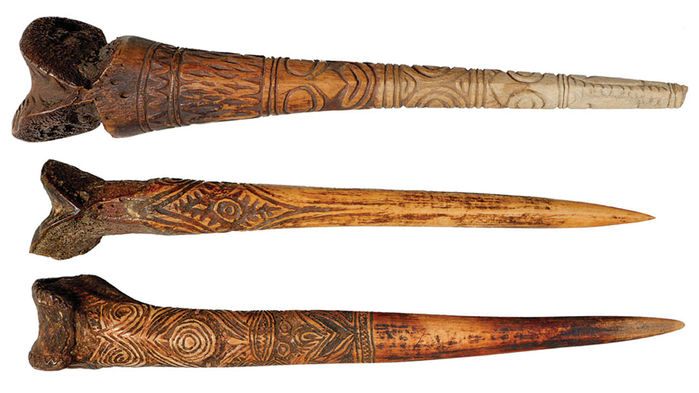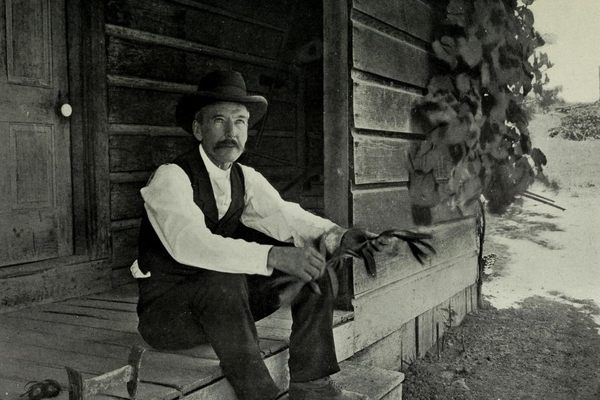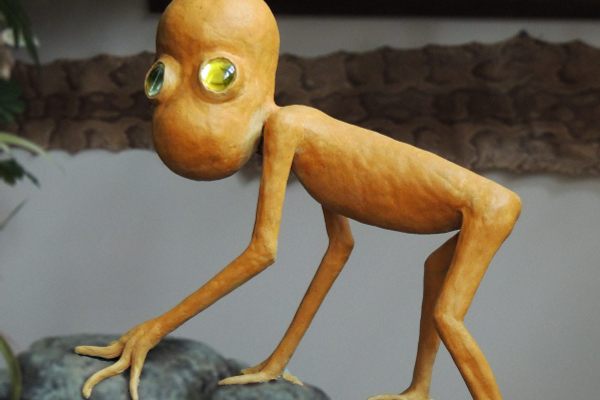New Guineans Made Intricately Carved Daggers From Human Bones
These deadly relics were symbols of power and prestige.

At the sight of these New Guinean daggers, you’d think they were made from wood or maybe ivory. Not quite. The bottom one comes from a cassowary. The first two were made from the femurs of warriors on the South Pacific island around 100 years ago.
In the late 19th and early 20th centuries, bone daggers were carved from the tibiotarsus (upper leg bone) of cassowaries, a flightless bird native to New Guinea. The daggers symbolized strength and social prestige within the community, which was often defined by the number of enemies and cassowaries killed. According to Dartmouth College anthropologist Nathaniel J. Dominy, it’s unclear what the intricately sculpted designs of geometric shapes, lines, faces, birds, and crocodiles on these daggers represent, but they are most often interpreted as power symbols. “The most powerful images were on the handle,” wrote Dominy, so the user could harness the power by gripping the handle.
Human bone daggers, however, are rare compared to cassowary bone daggers, which you can still find on eBay. Out of roughly 499 bone daggers housed at the American Museum of Natural History in New York, Harvard’s Peabody Museum of Archaeology and Ethnology, and the Field Museum in Chicago, only 21 are human. These daggers were carved from the femurs of men who were victorious on the battlefield or vanquished rivals who had racked up a high number of kills. “It was the possession of a human bone that entitled you the rights, magic, and prestige of the man who was the source of the bone,” wrote Dominy.
For decades, groups in northern New Guinea used bone daggers during close combat to stab enemies in the throat, wound their hip or leg joints, or incapacitate prisoners to assure victory. It’s unknown when and for how long New Guineans in the Sepik region started using human bone daggers, but the carving custom tapered off near the end of the 19th century or early 20th century.

Since then, anthropologists have wondered how these valuable possessions withstood the blunt force of brutal battles without breaking. Dominy, who has studied bone daggers for years, and a team of researchers from Dartmouth College, the University of Colorado, Denver, and the University of Maine, Orono, were determined to find the answer. For their study, the team acquired five human bone and six cassowary daggers from the Hood Museum of Art at Dartmouth College and a private dealer. They scanned the daggers with a CT scanner, jabbed the weapons through urethane casting material to simulate stabbing a human joint, and tested the daggers’ resistance to bending with a uniaxial mechanical tester.
The CT scanner results showed that cassowary daggers were much flatter than the curved daggers carved from human bone. Mechanical testing demonstrated that human bones have a greater resistance to bending. The urethane test revealed that the material stiffness and strength of human and bird daggers were actually fairly similar. Using the cassowary data, the research team employed computer simulations to evaluate the bird daggers’ mechanical force compared to human bone daggers. The simulations determined that the human bone weapons were far stronger than the cassowary daggers.
This superiority, the researchers surmise, is due to the curved structure of the human bone daggers. “When men are shaping the dagger from a human femur they retain a lot of the cross-sectional curvature,” Dominy told The Washington Post.
They are not sure if and why the dagger-makers intentionally carved the flat cassowary daggers to be frailer than their human bone counterparts. It’s possible, the researchers speculate, that dagger-makers carved the cassowary daggers to be lightweight, easy to carry, and replaceable when broken. What seems plausible is human bone daggers as symbols of strength were sculpted to weather flesh, bone, and time.







Follow us on Twitter to get the latest on the world's hidden wonders.
Like us on Facebook to get the latest on the world's hidden wonders.
Follow us on Twitter Like us on Facebook